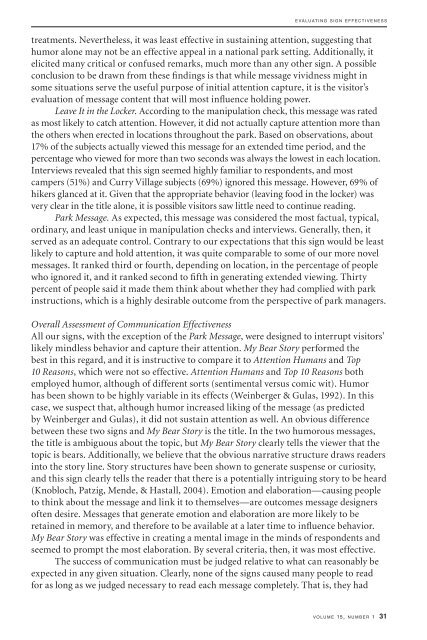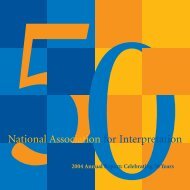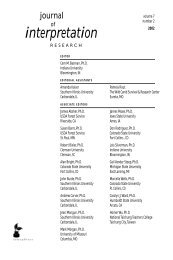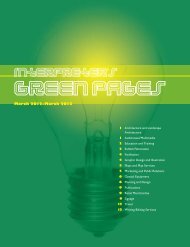interpretation
Volume 15, Number 1 - National Association for Interpretation
Volume 15, Number 1 - National Association for Interpretation
Create successful ePaper yourself
Turn your PDF publications into a flip-book with our unique Google optimized e-Paper software.
e v a l u a t i n g s i g n e f f e c t i v e n e s s<br />
treatments. Nevertheless, it was least effective in sustaining attention, suggesting that<br />
humor alone may not be an effective appeal in a national park setting. Additionally, it<br />
elicited many critical or confused remarks, much more than any other sign. A possible<br />
conclusion to be drawn from these findings is that while message vividness might in<br />
some situations serve the useful purpose of initial attention capture, it is the visitor’s<br />
evaluation of message content that will most influence holding power.<br />
Leave It in the Locker. According to the manipulation check, this message was rated<br />
as most likely to catch attention. However, it did not actually capture attention more than<br />
the others when erected in locations throughout the park. Based on observations, about<br />
17% of the subjects actually viewed this message for an extended time period, and the<br />
percentage who viewed for more than two seconds was always the lowest in each location.<br />
Interviews revealed that this sign seemed highly familiar to respondents, and most<br />
campers (51%) and Curry Village subjects (69%) ignored this message. However, 69% of<br />
hikers glanced at it. Given that the appropriate behavior (leaving food in the locker) was<br />
very clear in the title alone, it is possible visitors saw little need to continue reading.<br />
Park Message. As expected, this message was considered the most factual, typical,<br />
ordinary, and least unique in manipulation checks and interviews. Generally, then, it<br />
served as an adequate control. Contrary to our expectations that this sign would be least<br />
likely to capture and hold attention, it was quite comparable to some of our more novel<br />
messages. It ranked third or fourth, depending on location, in the percentage of people<br />
who ignored it, and it ranked second to fifth in generating extended viewing. Thirty<br />
percent of people said it made them think about whether they had complied with park<br />
instructions, which is a highly desirable outcome from the perspective of park managers.<br />
Overall Assessment of Communication Effectiveness<br />
All our signs, with the exception of the Park Message, were designed to interrupt visitors’<br />
likely mindless behavior and capture their attention. My Bear Story performed the<br />
best in this regard, and it is instructive to compare it to Attention Humans and Top<br />
10 Reasons, which were not so effective. Attention Humans and Top 10 Reasons both<br />
employed humor, although of different sorts (sentimental versus comic wit). Humor<br />
has been shown to be highly variable in its effects (Weinberger & Gulas, 1992). In this<br />
case, we suspect that, although humor increased liking of the message (as predicted<br />
by Weinberger and Gulas), it did not sustain attention as well. An obvious difference<br />
between these two signs and My Bear Story is the title. In the two humorous messages,<br />
the title is ambiguous about the topic, but My Bear Story clearly tells the viewer that the<br />
topic is bears. Additionally, we believe that the obvious narrative structure draws readers<br />
into the story line. Story structures have been shown to generate suspense or curiosity,<br />
and this sign clearly tells the reader that there is a potentially intriguing story to be heard<br />
(Knobloch, Patzig, Mende, & Hastall, 2004). Emotion and elaboration—causing people<br />
to think about the message and link it to themselves—are outcomes message designers<br />
often desire. Messages that generate emotion and elaboration are more likely to be<br />
retained in memory, and therefore to be available at a later time to influence behavior.<br />
My Bear Story was effective in creating a mental image in the minds of respondents and<br />
seemed to prompt the most elaboration. By several criteria, then, it was most effective.<br />
The success of communication must be judged relative to what can reasonably be<br />
expected in any given situation. Clearly, none of the signs caused many people to read<br />
for as long as we judged necessary to read each message completely. That is, they had<br />
v o l u m e 15, n u m b e r 1 31












